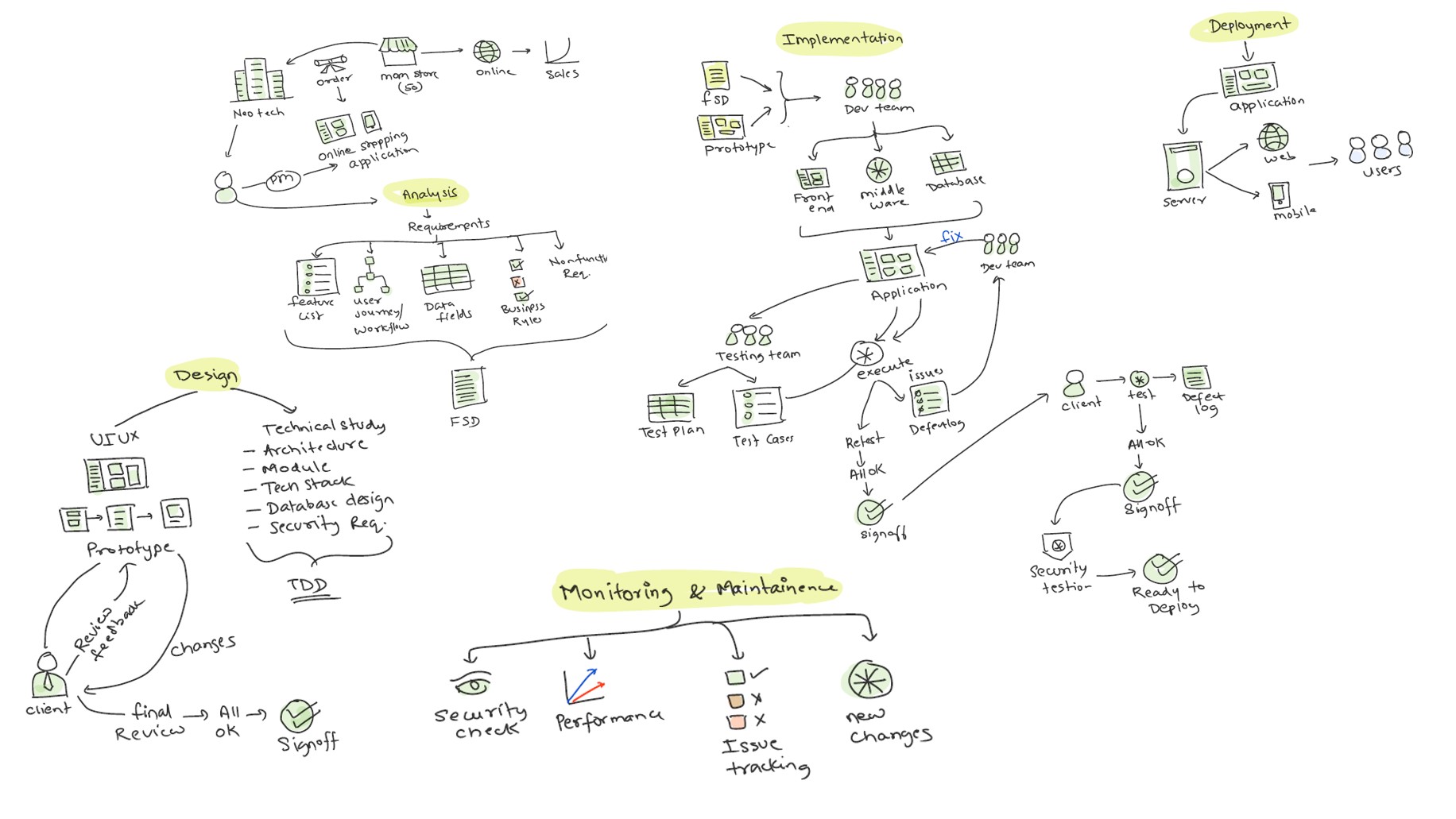SDLC Waterfall Model for BA/PM: What IT Companies Expect You to Know
The Waterfall Model: A Step-by-Step Guide to Software Development
A practical walkthrough of the classic SDLC approach with examples, best practices, and when to use it.

The Waterfall Model is a foundational Software Development Life Cycle (SDLC) methodology that moves throughlinear, sequential phases. Like water flowing downward, each phase completes before the next begins. Using the example of an online grocery shopping application, this guide explains each phase with activities, examples, and best practices.
Phase 1: Analysis
The project starts with a detailed requirement analysis. A BA/PM gathers business needs and documents them into aFunctional Specification Document (FSD).
Purpose
Define what the system should do and capture all business needs.
Activities
- Meet stakeholders and elicit requirements
- Document functional & non-functional requirements
- Identify business rules, data needs, workflow scenarios
- Compile everything into the FSD
Example (Grocery App)
- Product search, filtering, sorting
- Add to cart & checkout process
- Payment gateway integration
- Delivery slot booking
Best Practices
- Include both business & technical stakeholders
- Use wireframes/prototypes to reduce ambiguity
- Freeze scope before moving forward
Phase 2: Design
With requirements baselined, the team creates UI/UX designs and a technical blueprint documented in aTechnical Design Document (TDD).
Activities
- High-Level Design (architecture, modules, tech stack)
- Low-Level Design (DB schema, APIs, algorithms)
- UI/UX wireframes and usability considerations
- Security & scalability planning
Example (Grocery App)
- Decide web vs. mobile or both
- Design product/order/customer schemas
- Responsive screens for different devices
Best Practices
- Prototype core journeys early
- Document integration points clearly
- Address security up front (auth, data protection)
Phase 3: Implementation
Developers build the application per the FSD and TDD—front-end, middleware, and database—until a working system is ready.
Activities
- Set up environments & CI/CD (if applicable)
- Code modules and integrate
- Version control with Git
Example (Grocery App)
- Backend APIs for products, orders, payments
- Frontend (e.g., React/Next.js)
- Auth & payment integrations
Best Practices
- Follow coding standards & perform code reviews
- Write unit tests alongside code
- Keep design & FSD handy for quick reference
Phase 4: Testing
QA validates the system against the FSD using a Test Plan and detailed Test Cases. Defects are logged and fixed.
Activities
- Functional & integration testing
- Performance & security testing
- User Acceptance Testing (UAT)
- Defect tracking & re-testing
Example (Grocery App)
- Search → Add to Cart → Checkout → Payment flow
- Discounts & taxes apply correctly
Best Practices
- Test early, test often
- Involve end users for UAT
- Keep test evidence for audit/compliance
Phase 5: Deployment
After passing tests and security checks, the application is released to production and made available to customers.
Activities
- Production deployment & smoke testing
- User training (if required)
- Migration/cut-over (if replacing an older system)
Best Practices
- Have a rollback plan
- Monitor early usage closely
Phase 6: Maintenance & Monitoring
Post-release, the team fixes issues, ships enhancements, and monitors performance and security.
Activities
- Bug fixes & optimization
- Feature updates & compliance changes
- Security reviews and monitoring
Best Practices
- Maintain a clear change log
- Schedule periodic security audits
Advantages
- Clear documentation at every stage
- Predictable cost and timeline
- Easy to manage with defined milestones
- Good for small/medium projects with stable requirements
Limitations
- Rigid—changes late in the cycle are costly
- Testing occurs after development (defects found later)
- Not ideal for evolving requirements
When to Use
- Requirements are clear and fixed
- Technology stack is well understood
- Compliance-heavy industries (banking, healthcare, government)
Summary
The Waterfall Model remains a disciplined, documentation-driven SDLC approach best suited to projects demanding clarity and predictability. While Agile dominates modern delivery, Waterfall is still valuable where scope is stable and compliance is critical.

